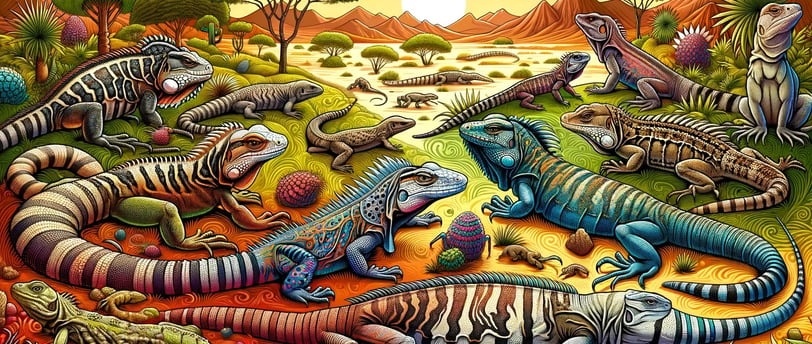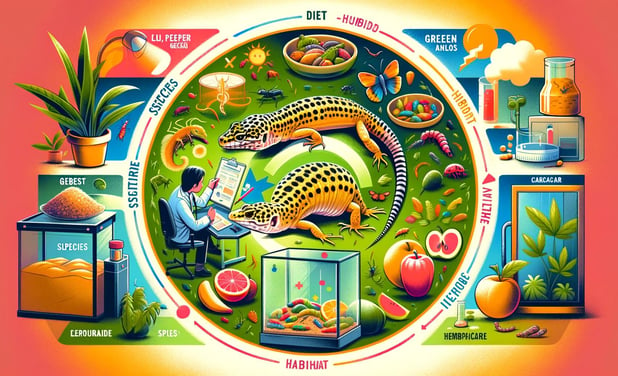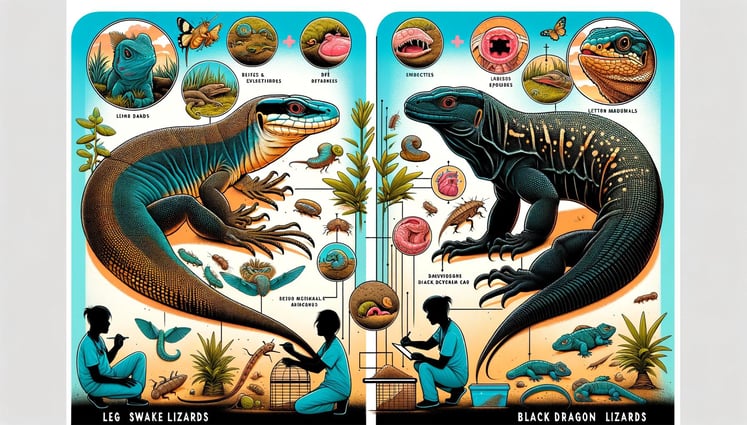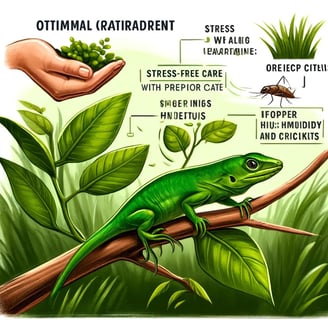The LifeSpan of Lizards: How Long Do Different Lizards Live?


Introduction
Lizards are fascinating reptiles with a diverse range of species, each exhibiting unique traits and lifespans. From the agile geckos to the imposing monitor lizards, these creatures captivate us with their varied behaviors and adaptability. Understanding the life span of lizards can help pet owners provide better care and ensure their lizards lead healthy lives.
Lizards can be found in almost every corner of the world, thriving in a range of environments from deserts to rainforests. This wide distribution has led to an incredible diversity of species, each with its own specific needs and characteristics. For instance, some lizards are known for their vibrant colors and ability to change hues, while others are renowned for their speed or climbing abilities. Despite these differences, one commonality among all lizard species is the importance of proper care in determining their longevity.
In this blog, we'll explore the various factors that influence the lifespan of lizards, such as their natural habitat, diet, and overall care. By understanding these factors, lizard owners can create environments that mimic natural conditions, promoting longevity and well-being. We'll also delve into specific care tips for popular lizard species, providing practical advice to help ensure your pet thrives.
On 'Death In Paradise,' I had a CGI pet lizard and had to react to nothing, which was hideously embarrassing ~ Ben Miller
Understanding the Life Span of Lizards: An Overview
The life span of lizards varies significantly among species. For example, small geckos may live for 6-10 years, while larger lizards like iguanas can live up to 20 years or more. Factors such as habitat, diet, and care play crucial roles in determining how long a lizard will live. It's essential for lizard owners to understand these factors to ensure their pets live long, healthy lives.
Factors Influencing the LifeSpan of Lizards
Several factors influence the lifespan of lizards, including:
Species: Different lizard species have varying life spans. For example, Leopard Geckos can live up to 20 years, while the Green Anole typically lives for around 5 years.
Diet: A balanced diet rich in nutrients is vital for a lizard's health and longevity. Poor nutrition can lead to health problems and shorten their lifespan.
Habitat: Providing a suitable habitat with proper temperature, humidity, and lighting is crucial. An inadequate environment can stress the lizard and lead to a shorter life span.
Healthcare: Regular veterinary check-ups and prompt treatment of illnesses are essential to maintain a lizard's health.
Lizards Care: Tips for Prolonging Your Lizard’s Life
Proper care is crucial to ensure your lizard lives a long and healthy life. Here are some tips:
Provide a Balanced Diet: Ensure your lizard's diet includes a variety of insects, fruits, and vegetables, depending on the species.
Maintain the Right Habitat: Keep the enclosure clean and provide the appropriate temperature, humidity, and lighting.
Regular Health Check-ups: Schedule regular vet visits to monitor your lizard's health and address any issues promptly.
Reduce Stress: Avoid handling your lizard too much and provide hiding spots in the enclosure to reduce stress.
The Fascinating Life Span of Black Dragons Lizards
Black Dragon lizards, also known as Black Dragon Monitor lizards, can live up to 20 years in captivity with proper care. These lizards require a spacious enclosure, a diet rich in protein, and specific temperature and humidity levels. Providing the right environment and care is crucial for their longevity.
Comparing the Life Span of Snake Lizards and Black Dragons Lizards
Snake Lizards: A Unique Group
Snake lizards, also known as legless lizards, are a unique group of reptiles that resemble snakes due to their elongated, limbless bodies. Despite their appearance, they are true lizards and possess distinct characteristics that set them apart from snakes, such as eyelids and external ear openings. The lifespan of snake lizards can vary widely among species, but they generally live for about 10 to 20 years in captivity. Proper care, including a suitable diet, habitat, and regular veterinary check-ups, can significantly impact their longevity.
Black Dragon Lizards: The Majestic Giants
Black Dragon lizards, scientifically known as Varanus komodoensis, are a subspecies of Komodo dragons. These majestic creatures are among the largest lizards in the world and can live for an impressive 20 to 30 years in captivity. Their longevity is influenced by several factors, including their diet, habitat, and overall care. In the wild, their lifespan may be shorter due to environmental pressures and threats such as predation and habitat loss.
Key Differences in Lifespan
Species Longevity:
Snake Lizards: Typically live between 10 to 20 years in captivity.
Black Dragon Lizards: Can live up to 20 to 30 years in captivity.
Diet and Nutrition:
Snake Lizards: Generally, feed on a diet of insects, small mammals, and other invertebrates. A balanced diet is crucial for their health and longevity.
Black Dragon Lizards: Require a diet rich in protein, often consisting of large prey items such as rodents, birds, and carrion. Proper nutrition is vital for maintaining their large size and health.
Habitat and Environment:
Snake Lizards: Thrive in environments that mimic their natural habitats, which can include burrows and sandy or rocky substrates. Maintaining appropriate temperature and humidity levels is essential.
Black Dragon Lizards: Require spacious enclosures with access to both land and water. They need specific temperature and humidity conditions to mimic their natural habitat and support their large size.
Healthcare and Maintenance:
Snake Lizards: Regular health check-ups, monitoring for signs of illness, and maintaining a clean habitat are important for their well-being.
Black Dragon Lizards: Due to their size and potential for aggression, they require experienced handling and regular veterinary care to monitor their health and address any issues promptly.
Similarities in Care
Despite the differences in lifespan and specific needs, both snake lizards and Black Dragon lizards benefit from a few common care practices:
Balanced Diet: Providing a diet appropriate to the species is crucial for health and longevity.
Suitable Habitat: Creating an environment that mimics their natural habitat helps reduce stress and supports their well-being.
Regular Veterinary Care: Routine check-ups with a reptile veterinarian can help detect and address health issues early.
By understanding the unique needs and characteristics of both snake lizards and Black Dragon lizards, owners can provide the best care possible, ensuring their pets lead long and healthy lives. Whether you are caring for a sleek, legless lizard or a formidable Black Dragon, knowledge and dedication are key to their well-being and longevity.
The Truth About Robo Alive Lizards: How Long Do They Last?
Robo Alive lizards are a fascinating blend of technology and entertainment, designed to mimic the movements and behaviors of real lizards. These battery-operated toys are especially popular among children, providing a fun and interactive way to engage with nature-inspired play. However, unlike real lizards that require careful attention and specific care to thrive, Robo Alive lizards have a different set of requirements centered around their power source and durability.
Understanding the "Life Span" of Robo Alive Lizards
The term "lifespan" for Robo Alive lizards is quite different from that of living lizards. Instead of biological factors, the longevity of these toy lizards depends on the battery life and how frequently they are used. Typically, the initial set of batteries included with the toy may last for a few hours of continuous play. Here are some factors that can influence the playtime and overall longevity of Robo Alive lizards:
Battery Type and Quality:
The type of batteries used in Robo Alive lizards can significantly affect their operating time. High-quality alkaline batteries tend to last longer compared to cheaper alternatives.
Rechargeable batteries are a cost-effective and environmentally friendly option that can extend the toy's usability over time.
Frequency of Use:
The more frequently the toy is used, the quicker the batteries will deplete. Continuous play sessions will drain the batteries faster than intermittent use.
Parents can manage playtime to balance fun and battery conservation, ensuring longer periods of enjoyment between battery changes.
Durability and Maintenance:
Robo Alive lizards are designed to withstand the rough and tumble of play, but they are still subject to wear and tear. Proper handling and maintenance can prolong the toy's life.
Ensuring that the toy is not exposed to water, dirt, or excessive force can help maintain its functionality.
Battery Replacement:
Replacing the batteries as needed is a straightforward way to extend the life of Robo Alive lizards. Most models have an easy-to-access battery compartment for quick changes.
Keeping spare batteries on hand ensures that playtime is not interrupted for long periods.
The Appeal of Robo Alive Lizards
The popularity of Robo Alive lizards stems from their realistic movements and interactive features. These toys can crawl, flick their tongues, and move their tails, providing an engaging experience for children. The lifelike behavior of these toys can spark curiosity about real lizards and foster an interest in learning more about reptiles.
Here are some reasons why Robo Alive lizards are a hit among children and parents alike:
Educational Value: While playing with Robo Alive lizards, children can learn about the movements and behaviors of real lizards, promoting an interest in wildlife and science.
Interactive Play: These toys offer a dynamic play experience, encouraging kids to engage in imaginative play and develop their motor skills.
No Maintenance: Unlike real lizards, Robo Alive lizards do not require feeding, cleaning, or special care, making them a hassle-free option for parents.
Final Thoughts
While the life span of Robo Alive lizards is determined by battery life and usage rather than biological factors, they offer a unique and enjoyable way for children to interact with lifelike lizards. Proper battery management and gentle handling can ensure that these toys provide hours of fun and entertainment. For parents seeking an educational yet maintenance-free alternative to real pets, Robo Alive lizards are an excellent choice. They capture the essence of real lizards' movements and behaviors, sparking joy and curiosity in young minds.
Common Questions: Can Lizards Get Cancer?
Yes, lizards can get cancer. Like other animals, lizards are susceptible to various types of cancers, including skin cancer, internal tumors, and bone cancer. Early detection and treatment are crucial for managing cancer in lizards. Regular veterinary check-ups and monitoring for any unusual lumps or changes in behavior can help in early diagnosis and treatment.
What Lizard Has the Shortest Lifespan? Exploring Species Differences
The Green Anole is known to have one of the shortest lifespans among lizards, typically living around 5 years in captivity. Factors such as environmental stress, diet, and care play a significant role in determining their life span. Providing optimal care and a stress-free environment can help maximize their life span.
What is a 24-Hour Lizard? Understanding Rapid Life Cycles
The term "24 Hour Lizard" refers to the Mourning Gecko (Lepidodactylus lugubris), which has a rapid reproductive cycle. These lizards can reproduce without a mate (parthenogenesis) and can lay eggs frequently. However, the term "24 Hour Lizard" is more of a nickname and does not imply that the lizard only lives for 24 hours. Mourning Geckos can live up to 10 years with proper care.
Conclusion
Understanding the life span of lizards is essential for providing the best care and ensuring their longevity. Different species have varying lifespans influenced by factors such as diet, habitat, and healthcare. By following proper lizard care guidelines and addressing their specific needs, lizard owners can help their pets live long, healthy lives. Whether you're caring for a Black Dragon lizard or a Green Anole, understanding the life span of lizards is key to their well-being.
The LifeSpan of Lizards: How Long Do Different Lizards Live?








Blogging
Your go-to platform for top blogging insights.
Connect
Explore
info@blogwaly.com
+92-316-8810243
© 2024. All rights reserved.
